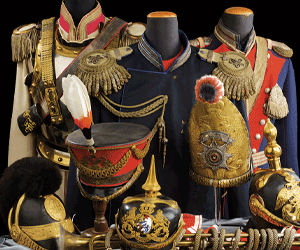Order of Leopold, Type III, Military Division, I Class Breast Star
SKU: 01.AUT.0104.405.01
Estimated market value:



Estimated market value:
Attributes
History
The Austrian Empire was created in 1804. That same year, an unknown source proposed the foundation of a new Austrian Order to exist alongside the two existing orders – the Military Order of Maria Theresa and the Order of St. Stephen. These two orders were largely reserved for military officers, and civil officers of the high courts, foreigners and nobility. This new order was to be available to all citizens from all crown lands for merit, charitable service, cultural/innovative achievements or for loyalty to the ruler. The order was officially founded on January 8, 1808.
The “Order of Rudolf” as it was to be initially called, may have been proposed to rally nationalistic fervor in the context of the political context – the Holy Roman Empire on one side and Napoleonic France on the other. The statutes were composed by Johann Philipp Karl Stadion Count von Warthausen, the Minister of the House and Foreign Affairs, in December 1807. It was decided by the Emperor that the order should be named after his father, Emperor Leopold II (1747-1792). After thoughtful consideration of numerous mottos and initials, it was decided to adopt “Integritati et Merito” (for integrity and merit).
The insignia consisted of a red enamelled eight-point Leopold Cross with three golden oak leaves and two acorns in each quadrant. The centre medallion bears the initials F.I.A on the obverse, with the inscription mentioned previously. The reverse includes the motto of Emperor Leopold II, “Opes Regum Corda Sumbditorum” (the power of rulers lies in the heart of their subjects). The whole decoration is surmounted by the Austrian Imperial Crown.
Three classes were established: Grand Cross (with collar), Commander, and Knight’s Cross. The Grand Master was the only one who could confer awards. Type I (180-1812) is the first period, as it captures the earliest physical change to the order. In 1812, the oak leaves were omitted from inbetween the arms of the cross, and the embroidered oak leaves on the star became gilt. Type II (1812-1860) is signified by various makers, often smaller crosses (37mm Commanders Cross and 27mm Knight’s Cross). In 1846/1847 the star became made entirely of metal instead of embroidery, however this practice was often used several years before being officially changed.
There were many changes made in Type III. In 1860, to distinguish achievements at war, a “war decoration” was introduced. Moreover, the crowns were to be created in convex form with inner caps enamelled red. Due to the introduction of the war decoration, a lower grade was inducted to counterset the ability of a member to rise through the military division easier than those in the civil division. In 1862, the Knights Cross became framed in a golden hoop. Roughly ten years later, the Star to the Grand Cross was to have faceted rays instead of smooth rays. At this time, the war decoration became enamelled green, instead of alloyed green.
In 1900, the structure of the order changed to include the “First Class” Grand Cross, which was an intermediate award (between commander’s cross and Grand Cross), for foreigners. The First Class was a similar design to the Grand Cross but was smaller and worn on a different sash to make a clear distinction.
In 1908, the ‘small decorations’ were added for the Grand Cross and the First Class Cross to accommodate new field uniforms. They consisted of knight’s cross with the small relevant star on the ribbon. For war decorations on the lower grade, the Knight’s Cross was adorned with a laurel wreath around the central medallion.
In 1916, the statues were completely revised by Emperor Karl I. Two crossed swords were added to awards that were give for courageous acts against an enemy and for achievements in leadership. The swords were to pass through the central medallion, and on the Knight’s Cross they would be worn on the ribbon. The decorations with swords were only awarded to Austro-Hungarian armed forces members.
A “small decoration” was introduced for the Commander’s Cross in 1917. This decoration was a small imperial crown for peacetime, and an imperial crown with two bend up laurel wreaths for war decorations, a Knight’s Cross with a laurel wreathe around the central medallion and a simple imperial crown mounted on the ribbon for the “war decoration” of a lower grade. This introduction affected those who had already received this class, and so and “intermediate class” was added and consisted of a golden bar attached to the ribbon. This was also the case for the knight’s cross.

Versions
$3000+ USD
Silver/Gold/Enamelled
Obv: FIA INTEGRITATI ET MERITO
Rothe & Neffe; Vincent Mayer's Sohne; Rozet & Fischmeister
$5000+ USD
Silver/Gold/Enamelled
Obv: FIA INTEGRITATI ET MERITO
Rothe & Neffe; Vincent Mayer's Sohne; Rozet & Fischmeister
N/A
Silver/Gold/Enamelled
Obv: FIA INTEGRITATI ET MERITO
This example is available on eMedals for $2,760 in May 2020.
$5400 USD
Silver/Silver gilt/Enamelled
Obv: FIA INTEGRITATI ET MERITO
Rothe & Neffe
The pictured example is a museum quality reproduction.
N/A
Silver/Gold/Enamelled
Obv: FIA INTEGRITATI ET MERITO
Rothe & Neffe; Vincent Mayer's Sohne; Rozet & Fischmeister
N/A
Silver/Gold/Enamelled
Obv: FIA INTEGRITATI ET MERITO
Rothe & Neffe; Vincent Mayer's Sohne; Rozet & Fischmeister


Comments
Sign in to comment and reply.


Scroll Top